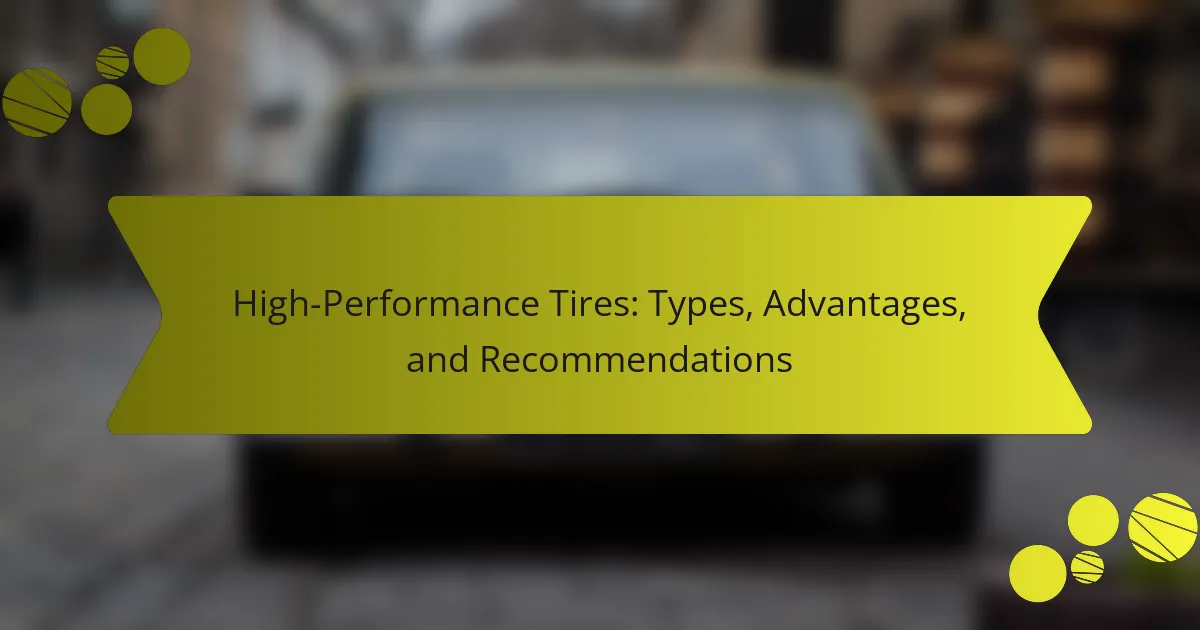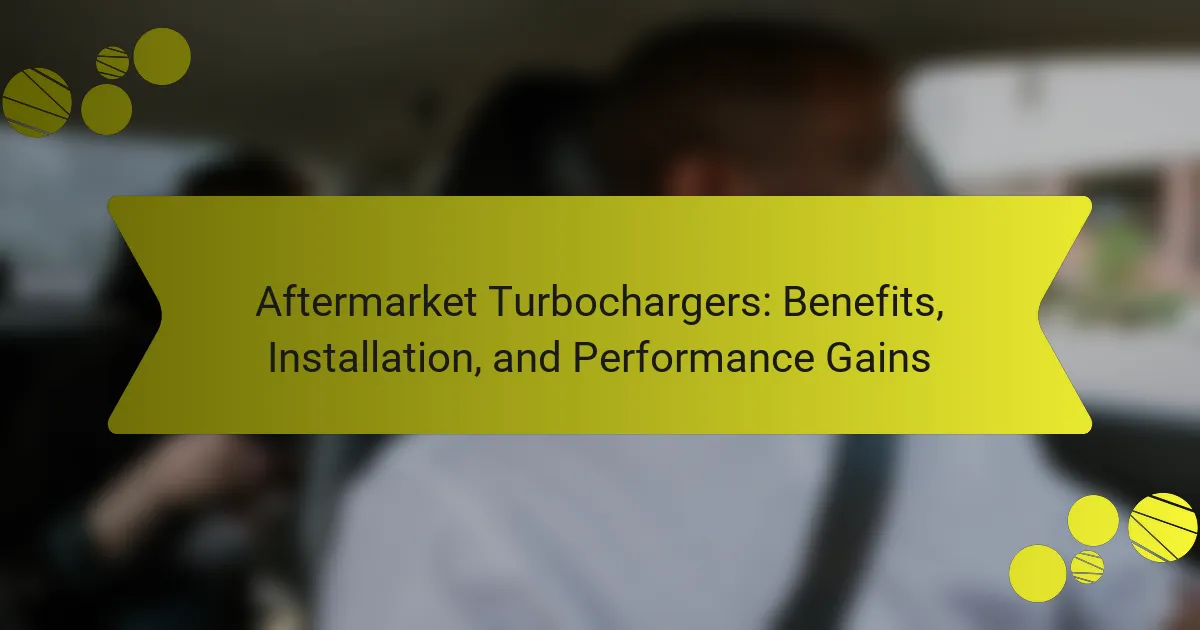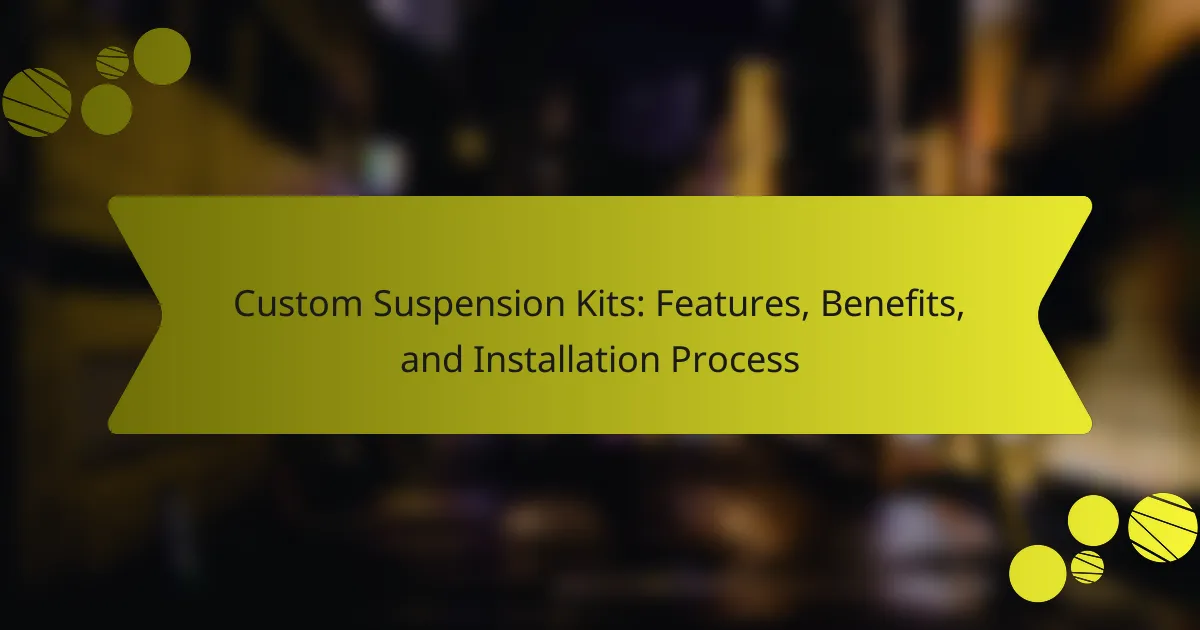High-performance tires enhance driving by providing superior grip, precise handling, and improved responsiveness. This article explores the types of high-performance tires, their advantages, and recommendations for choosing the right option based on driving style and conditions. Regular maintenance practices and common challenges associated with these tires will also be discussed.

What are the key characteristics of high-performance tires?
High-performance tires are designed for superior handling, traction, and speed. Key characteristics include enhanced grip on wet and dry surfaces, responsive steering, and improved cornering stability. They often feature a softer rubber compound, which provides better road contact but may reduce tread life. Additionally, high-performance tires usually have a wider contact patch and lower aspect ratio, contributing to their performance-oriented design.
How do high-performance tires differ from standard tires?
High-performance tires offer superior grip, handling, and responsiveness compared to standard tires. They feature softer rubber compounds and specialized tread patterns designed for enhanced traction and cornering stability. High-performance tires excel in performance conditions, while standard tires prioritize comfort and longevity. As a result, high-performance tires typically wear out faster but provide a more engaging driving experience.
What materials are commonly used in high-performance tires?
High-performance tires commonly use materials like synthetic rubber, carbon black, and silica. These materials enhance grip, durability, and performance under various conditions. Additionally, advanced compounds may include aramid fibers for strength and lightweight construction.
How does tread design affect performance in high-performance tires?
Tread design significantly influences the performance of high-performance tires by affecting grip, handling, and wear. Different tread patterns optimize traction in various conditions, enhancing stability and control. For example, wider grooves improve water evacuation, reducing hydroplaning risk. Additionally, unique tread designs can enhance cornering capabilities and braking efficiency, crucial for high-speed driving. The right tread design can maximize tire life while maintaining performance, making it a vital consideration for enthusiasts and competitive drivers.
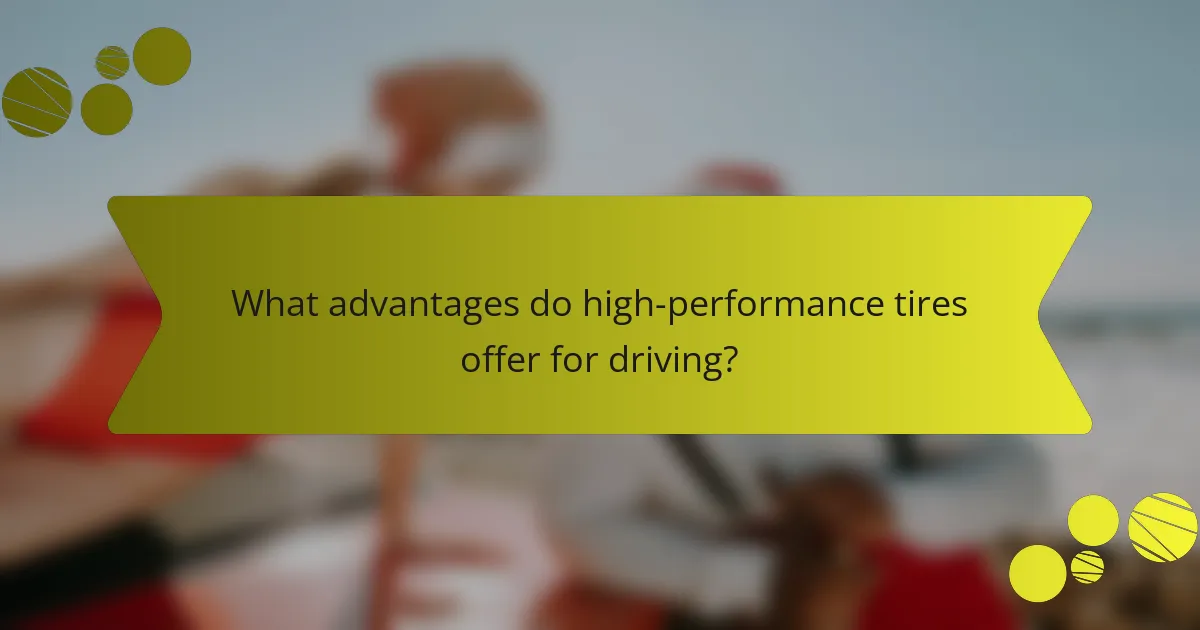
What advantages do high-performance tires offer for driving?
High-performance tires enhance driving by providing superior grip, precise handling, and improved responsiveness. These tires are designed for enhanced traction in various conditions, resulting in a safer and more enjoyable driving experience.
Their unique attributes include optimized tread patterns and softer rubber compounds, which contribute to better performance on both dry and wet surfaces. Additionally, high-performance tires often have a lower profile, which reduces sidewall flex and enhances cornering stability.
As a result, drivers experience increased control, especially during high-speed maneuvers. The benefits extend to shorter stopping distances, making them a preferred choice for sports cars and performance vehicles.
How do high-performance tires enhance handling and stability?
High-performance tires significantly enhance handling and stability by providing superior grip and responsiveness. These tires feature advanced rubber compounds and tread designs that optimize traction in various driving conditions. Improved cornering stability is achieved through a wider contact patch, which distributes weight more evenly. Additionally, high-performance tires often have stiffer sidewalls, reducing flex during sharp turns and enhancing overall vehicle control. As a result, drivers experience a more connected and confident feel on the road.
What role do high-performance tires play in fuel efficiency?
High-performance tires enhance fuel efficiency by reducing rolling resistance and improving traction. These tires are designed with specialized rubber compounds and optimized tread patterns, leading to better aerodynamics. As a result, vehicles experience less energy loss while moving, which directly translates to improved fuel economy. Additionally, high-performance tires can maintain optimal performance at higher speeds, further contributing to efficient fuel usage.
Why are high-performance tires important for safety in various driving conditions?
High-performance tires are crucial for safety across various driving conditions due to their enhanced grip, stability, and responsiveness. These tires feature advanced rubber compounds and tread designs that improve traction on wet, dry, and even snowy surfaces. For example, high-performance tires can reduce stopping distances by up to 30% compared to standard tires, significantly lowering the risk of accidents. Additionally, their ability to maintain control during high-speed maneuvers ensures better handling and driver confidence, making them essential for both everyday driving and performance-oriented scenarios.
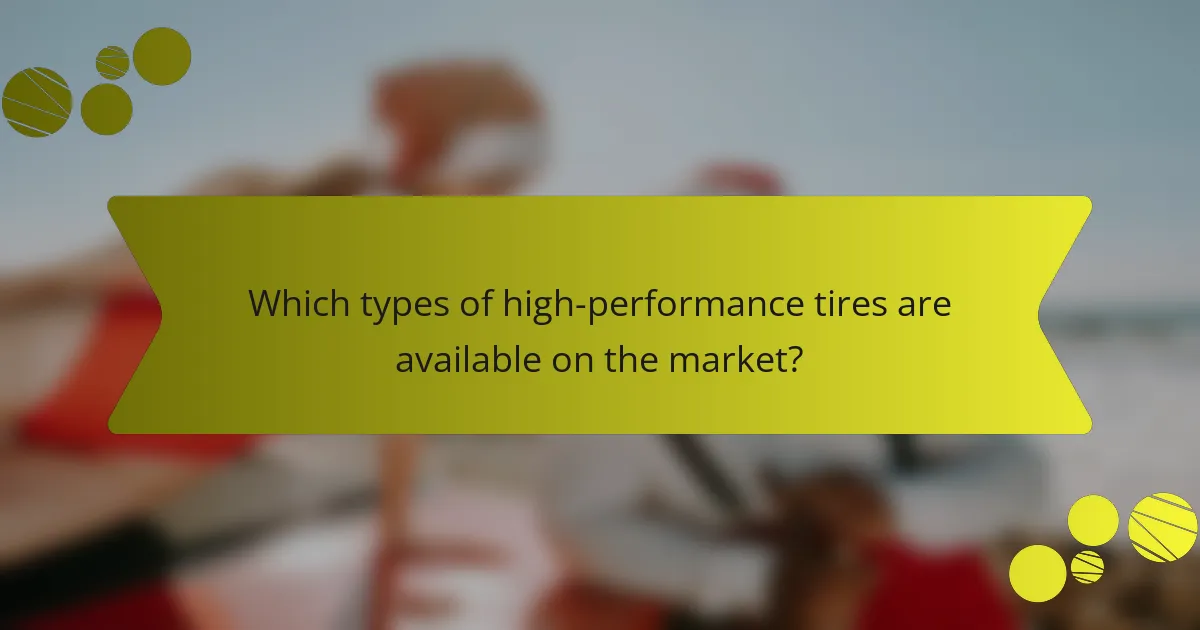
Which types of high-performance tires are available on the market?
High-performance tires come in several types, each designed for specific driving conditions and performance needs. The main types include summer tires, winter tires, all-season tires, and track tires.
Summer tires provide optimal grip on dry and wet roads, enhancing handling and braking. Winter tires feature specialized tread patterns and rubber compounds for improved traction in snow and ice. All-season tires offer a balance of capabilities, suitable for varying weather conditions. Track tires are designed for maximum performance on racetracks, prioritizing grip and responsiveness.
Each type has unique attributes that cater to different driving styles and environments, ensuring drivers can choose the best option for their needs.
What are the differences between summer, winter, and all-season high-performance tires?
Summer, winter, and all-season high-performance tires differ significantly in design and functionality. Summer tires excel in warm, dry, and wet conditions, offering superior grip and handling. Winter tires are specifically engineered for cold temperatures, snow, and ice, featuring deeper treads and softer rubber for enhanced traction. All-season tires aim to provide a balanced performance across various conditions, but may not match the specialized capabilities of summer or winter tires in extreme weather. Each type serves distinct driving needs based on seasonal conditions and performance expectations.
Which brands are recognized for their high-performance tire offerings?
Brands recognized for high-performance tire offerings include Michelin, Bridgestone, Pirelli, Goodyear, Continental, and Dunlop. These brands are known for their advanced technology, durability, and superior grip. Michelin excels in wet and dry conditions, while Pirelli focuses on sport performance. Goodyear offers innovative tread designs, and Bridgestone is noted for its balance of comfort and performance. Continental stands out for its eco-friendly options, and Dunlop is favored for its motorsport heritage. Each brand provides unique attributes catering to different driving needs and preferences.
What are the latest innovations in high-performance tire technology?
Recent innovations in high-performance tire technology include advancements in materials, design, and manufacturing processes. These innovations enhance grip, reduce rolling resistance, and improve durability. Notable developments include the use of silica-rich compounds for better wet traction and lightweight construction techniques that optimize performance without sacrificing safety. Additionally, smart tire technology integrates sensors to monitor tire pressure and temperature in real-time, promoting better handling and fuel efficiency.

How can you choose the right high-performance tires for your vehicle?
To choose the right high-performance tires for your vehicle, consider your driving style, climate, and vehicle specifications. Assess the tire’s tread pattern, rubber composition, and performance ratings. Look for tires that balance grip, durability, and comfort, ensuring they match your performance needs. Prioritize brand reputation and user reviews for informed decisions.
What factors should you consider when selecting high-performance tires?
When selecting high-performance tires, consider factors like tread design, rubber composition, and temperature resistance. Tread design affects grip and handling, while rubber composition influences durability and performance. Temperature resistance ensures optimal performance in varying conditions. Prioritize your driving style and vehicle compatibility for the best results.
How do tire size and specifications impact performance?
Tire size and specifications significantly impact performance by influencing handling, traction, and fuel efficiency. Larger tires often provide better grip and stability, while smaller tires can enhance acceleration and fuel economy.
Tire width affects contact with the road; wider tires improve cornering but may increase rolling resistance. Aspect ratio influences ride comfort; lower ratios offer sportier handling at the cost of a harsher ride.
Tread patterns determine traction in various conditions. For example, all-season tires balance performance across environments, while performance tires excel in dry conditions.
Selecting the right tire specification is crucial for optimizing vehicle performance, ensuring safety, and enhancing driving experience.
What are common misconceptions about high-performance tires?
High-performance tires are often misunderstood. A common misconception is that they are only suitable for racing or high-speed driving. In reality, they enhance handling and traction in various conditions, including wet roads. Another myth is that they wear out quickly; while some types may have softer compounds, many high-performance tires are designed for durability. Additionally, people often believe that these tires compromise comfort; however, advancements in technology have improved ride quality significantly. Lastly, there is a notion that high-performance tires are only for sports cars, but they are available for various vehicles, including sedans and SUVs.
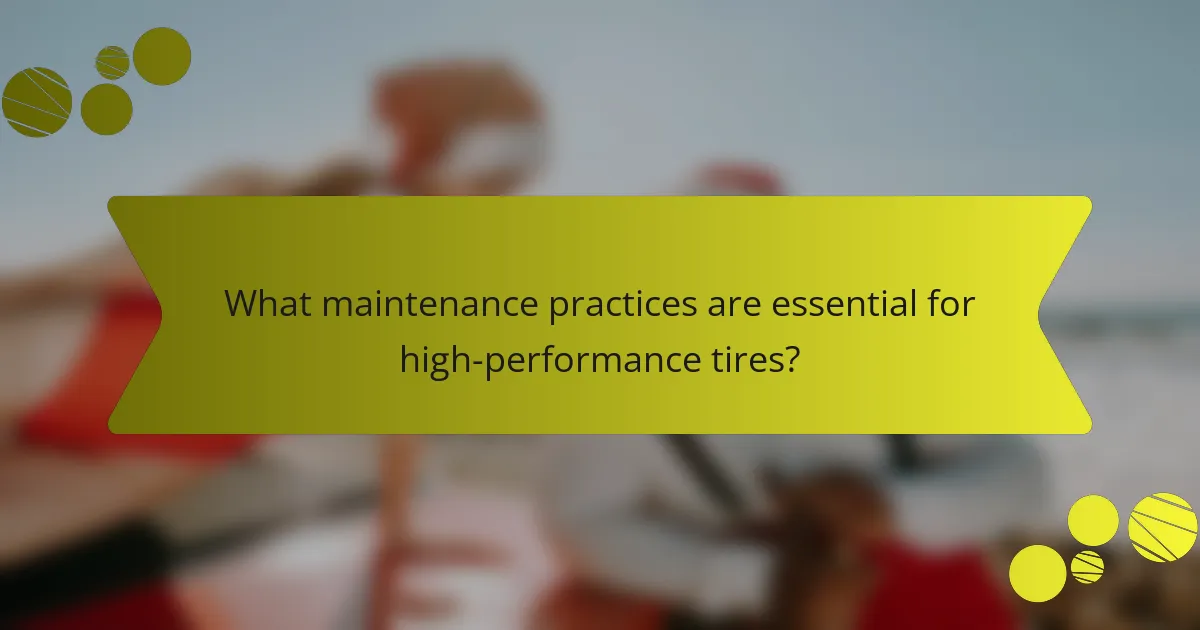
What maintenance practices are essential for high-performance tires?
Regular maintenance practices for high-performance tires include proper inflation, rotation, alignment, and tread depth checks. Maintaining optimal tire pressure enhances performance and safety. Rotating tires every 5,000 to 8,000 miles promotes even wear. Alignment adjustments prevent uneven tire wear and improve handling. Monitoring tread depth ensures adequate grip, especially in wet conditions.
How can you extend the lifespan of high-performance tires?
To extend the lifespan of high-performance tires, maintain proper tire pressure, rotate tires regularly, and avoid aggressive driving.
Proper tire pressure optimizes performance and prevents uneven wear. Regular rotations help distribute wear evenly across tires, enhancing longevity. Aggressive driving increases heat and stress, leading to faster degradation.
Additionally, store tires in a cool, dry place away from direct sunlight to prevent rubber deterioration. Inspect tires frequently for signs of damage or wear to address issues promptly.
What signs indicate that high-performance tires need replacement?
High-performance tires need replacement when tread depth is below 2/32 inches, signs of uneven wear are visible, or sidewall damage occurs. Additionally, if the tires exhibit frequent loss of air pressure or vibrations during driving, these are indications of deterioration. Regular inspections can help identify these issues early.
Which tire pressure guidelines should be followed for high-performance tires?
For high-performance tires, maintain pressure between 30 to 35 psi for optimal performance. This range ensures enhanced handling, stability, and tire wear. Check tire pressure regularly, especially before long drives or competitive events, as temperature changes can affect readings. Proper inflation promotes safety and maximizes the unique attributes of high-performance tires, such as traction and responsiveness.
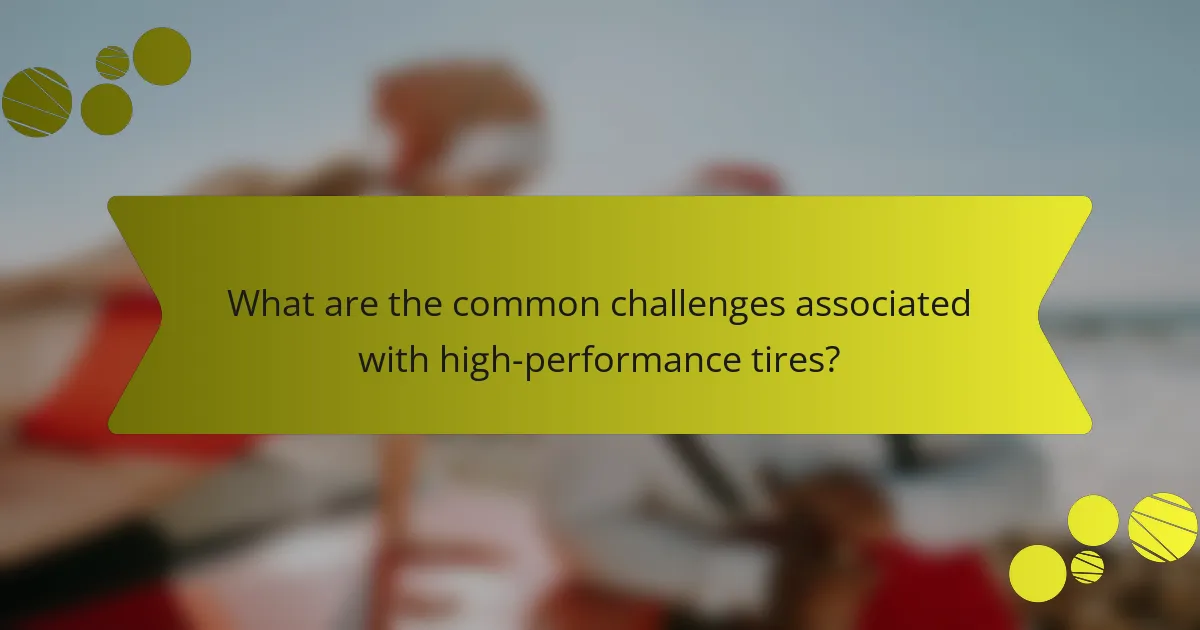
What are the common challenges associated with high-performance tires?
High-performance tires face several common challenges, including reduced tread life, increased road noise, and susceptibility to damage. These tires often wear out faster due to their softer compounds designed for better grip. They can also produce more noise on various surfaces, impacting comfort. Additionally, high-performance tires may be more prone to punctures and cuts, especially in harsh driving conditions.
How do high-performance tires perform in adverse weather conditions?
High-performance tires can struggle in adverse weather conditions, particularly in heavy rain, snow, or ice. Their design prioritizes handling and speed, which often compromises traction in such environments. For instance, high-performance tires typically have a shallower tread depth and a stiffer rubber compound, enhancing grip on dry surfaces but reducing performance on wet or slippery roads. In contrast, all-season or winter tires feature deeper treads and softer compounds, providing better traction in adverse conditions. Therefore, while high-performance tires excel in dry conditions, they may not be the best choice for inclement weather.
What are the cost considerations for high-performance tires?
High-performance tires can be costly due to advanced technology, materials, and manufacturing processes. Key cost considerations include the tire’s brand reputation, tread design, and performance characteristics. Premium brands may offer specialized features that enhance grip and durability, which can justify higher prices. Additionally, the expected lifespan and potential for improved fuel efficiency can impact long-term value.
How can you avoid common mistakes when using high-performance tires?
To avoid common mistakes when using high-performance tires, ensure proper tire pressure, maintain appropriate tread depth, and select tires suitable for your vehicle’s performance needs. Regularly check for alignment and balance to enhance handling and longevity. Additionally, avoid hard cornering and aggressive driving, which can lead to premature wear.
What expert tips can help you maximize the benefits of high-performance tires?
To maximize the benefits of high-performance tires, ensure proper maintenance and optimal driving conditions. Regularly check tire pressure, as it affects handling and wear. Rotate tires every 5,000 to 7,500 miles to promote even wear. Choose the right tire for your driving style; for example, summer tires excel in warm conditions, while all-season tires offer versatility. Additionally, alignments should be checked periodically to maintain performance.
